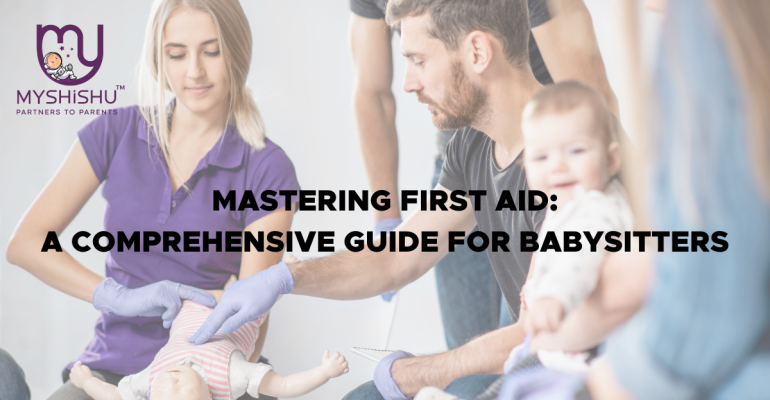Mastering First Aid: A Comprehensive Guide for Babysitters
Mastering First Aid: A Comprehensive Guide for Babysitters
Introduction
In the realm of babysitting, where the well-being of the little ones takes precedence, the importance of first aid cannot be overstated. Accidents can occur in the blink of an eye, emphasizing the critical need for babysitters to possess knowledge of first aid. This all-encompassing guide is dedicated to exploring the fundamental aspects of first-aid training designed explicitly for babysitters. From foundational principles to practical, hands-on techniques, join us on a journey to master the art of delivering immediate care in moments of urgency. Let’s commence our exploration into the world of babysitters.
Understanding the Importance of First Aid for Babysitters
What is first aid?
First aid is the initial assistance or care given to a person who is injured or suddenly becomes ill. In the context of babysitting, having a solid grasp of first aid principles is crucial. From minor scrapes and bruises to more serious incidents, the ability to respond promptly and effectively can prevent further harm and even save lives.
Why is first-aid training essential for babysitters?
Babysitters are entrusted with the well-being of children, and emergencies can arise at any moment. Whether it’s a kitchen mishap, a sudden allergic reaction, or a playground incident, being prepared with First Aid skills instills confidence and ensures a swift response to any situation. Parents, in turn, feel more at ease knowing their children are under the care of a responsible and prepared babysitter.
The Fundamentals of First-Aid For Babysitters
1. Recognizing Emergency Situations
The first step in providing effective first-aid is the ability to recognize when an emergency arises. Babysitters should be attuned to signs of distress, unusual behavior, or visible injuries. Understanding the urgency of the situation is crucial for taking appropriate action.
2. Basic Life Support (BLS) Techniques
BLS is a set of life-saving techniques that can be employed in emergencies such as cardiac arrest or choking. Babysitters should be familiar with cardiopulmonary resuscitation (CPR) for different age groups and techniques for clearing airways. Regular BLS training ensures that babysitters can confidently respond to critical situations.
3. Dealing with Common Injuries
From minor cuts and burns to insect bites and allergic reactions, babysitters should be well-versed in addressing common injuries. Proper wound cleaning, bandaging techniques, and knowing when to seek professional medical help are essential skills.
Tailoring First Aid for Children
4. Understanding Pediatric First-Aid
Children require specialized care, and first aid for them involves unique considerations. Babysitters must be knowledgeable about age-appropriate techniques, dosage calculations for medications, and recognizing signs of distress in children who may not be able to communicate their symptoms effectively.
5. Allergies and Anaphylaxis
Allergic reactions can escalate rapidly, and babysitters need to be prepared to administer epinephrine in cases of anaphylaxis. Understanding common allergens and recognizing symptoms is key to preventing severe reactions in children under your care.
First-Aid Supplies and Preparedness
6. Creating a First Aid Kit
A well-stocked first-aid kit is an indispensable tool for babysitters. This section covers the essentials of assembling a comprehensive kit, including bandages, antiseptics, medications, and emergency contact information. Regularly checking and replenishing the kit ensures readiness for any situation.
7. Emergency Action Plans
Babysitters should work with parents to create clear and concise emergency action plans. These plans outline steps to take in specific scenarios, including contact information for emergency services, nearby hospitals, and trusted neighbors or relatives.
Enrolling in First-Aid Courses
8. Benefits of Formal First-Aid Training
While basic first-aid knowledge is essential, enrolling in a formal first-aid training course offers numerous benefits. Accredited courses provide hands-on experience, scenario-based training, and certification that add credibility to a babysitter’s skill set.
9. Online vs. in-person training
In today’s digital age, babysitters have the option to choose between online and in-person First Aid courses. This section weighs the pros and cons of each, helping babysitters make informed decisions based on their preferences and schedules.
Navigating First-Aid Certification
10. Obtaining First-Aid Certification
Many parents prefer babysitters with formal First Aid certification. This section guides the steps to obtaining certification, including choosing reputable training providers and understanding the renewal process.
11. Maintaining First Aid Skills
First aid skills are perishable, and regular practice is crucial. Babysitters are encouraged to participate in refresher courses, stay updated on the latest guidelines, and maintain a proactive approach to continuous learning.
Integrating First-Aid into Babysitting Practices
12. Communicating with Parents
Effective communication with parents is key to providing the best care for their children. This section explores how babysitters can discuss their first aid training, emergency action plans, and any specific health concerns or conditions related to the children they are caring for.
13. Educating Children on Safety
Empowering children with basic safety knowledge can prevent accidents and injuries. Babysitters can play a vital role in teaching children about the importance of safety rules, identifying potential hazards, and understanding when to seek help.
FAQs Related To First-Aid For Babysitters
Here are a few commonly asked questions on first aid for babysitters
-
What should be in a babysitter’s first aid kit?
A babysitter’s first aid kit should include essentials like bandages, antiseptic wipes, scissors, a thermometer, gloves, and any specific medications provided by parents.
-
How can babysitters differentiate between minor injuries and emergencies?
Pay attention to signs of distress. Minor injuries can be managed with basic first aid, while severe conditions require immediate professional medical help.
-
How often should babysitters refresh their first-aid training?
Renew first aid certification every two years. Stay updated with the latest guidelines and consider periodic refresher courses for continued readiness.
-
What should babysitters do if a child is choking?
Perform the Heimlich maneuver by standing behind the child, making upward thrusts above the navel. Call emergency services if the child is unable to breathe or loses consciousness.
-
What’s essential in an emergency action plan for babysitters?
Include parent contacts, emergency services, hospital directions, and details on allergies or medical conditions. Regularly review the plan for clear communication and understanding of procedures.
Conclusion
In conclusion, mastering first-aid is an invaluable skill for babysitters. The ability to respond confidently and competently in emergencies not only safeguards the well-being of the children under their care but also provides peace of mind for parents. From recognizing emergencies to obtaining formal certification, this guide has covered the essential aspects of first aid training for babysitters. As you embark on your journey to becoming a well-prepared and responsible babysitter, remember that your commitment to first aid can make a significant difference in the lives of the children you care for.











